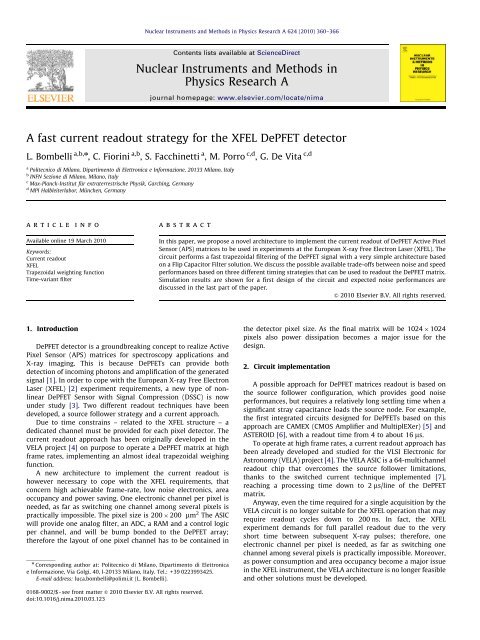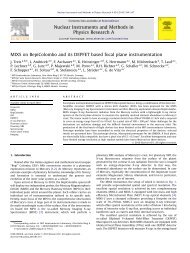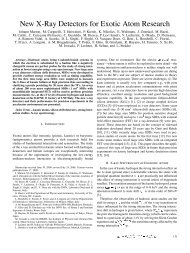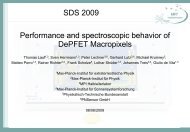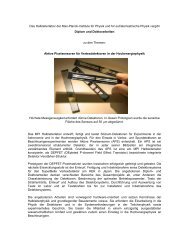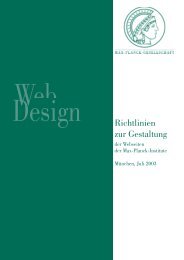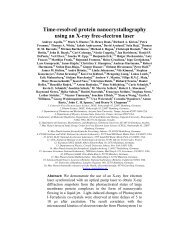A fast current readout strategy for the XFEL DePFET ... - MPG HLL
A fast current readout strategy for the XFEL DePFET ... - MPG HLL
A fast current readout strategy for the XFEL DePFET ... - MPG HLL
Create successful ePaper yourself
Turn your PDF publications into a flip-book with our unique Google optimized e-Paper software.
L. Bombelli et al. / Nuclear Instruments and Methods in Physics Research A 624 (2010) 360–366 365Table 1Time parameters vs. expected noise per<strong>for</strong>mances <strong>for</strong> <strong>the</strong> discussed timing <strong>readout</strong> strategies. The circuit noise includes contributions from both <strong>the</strong> filter stage and <strong>the</strong>programmable <strong>current</strong> source. Signal-to-noise ratios <strong>for</strong> incoming photons with an energy of 500 eV are also reported, to underline that it is possible to reach a satisfactoryS/N ratio, i.e. larger than 5, even with this energy if using <strong>the</strong> 1 and <strong>the</strong> 5 MHz with single baseline measure operation modes.Readout timing 5 MHz operation 1 MHz operation 5 MHz operation with single baseline measureSignal integration 40 ns 400 ns 80 nsENC (electrons) <strong>DePFET</strong> Circuit Total <strong>DePFET</strong> Circuit Total <strong>DePFET</strong> Circuit Total32e rms 25:3e rms 42e rms 10:3e rms 5:3e rms 11:6e rms 22:8e rms 14:8e rms 27:2e rmsSignal-to-noise at 1 keV photons 6.7 24 10.2Signal-to-noise at 500 eV photons 3.4 12 5.1Fig. 7. Standard deviation of <strong>the</strong> Poisson distribution <strong>for</strong> <strong>the</strong> incoming photons and of <strong>the</strong> electronic noise introduced by <strong>the</strong> FCF in <strong>the</strong> whole dynamic range. The ratio of<strong>the</strong> square of <strong>the</strong>se two parameters is also shown; this ratio increases at higher signal levels and remains greater than unity, and <strong>the</strong>re<strong>for</strong>e <strong>the</strong> total noise is alwaysdominated by <strong>the</strong> photon statistics, even if <strong>the</strong> electronics noise contribution increases due to <strong>the</strong> compressive behavior of <strong>the</strong> DSSC.photon detection is needed <strong>for</strong> low signal levels, <strong>the</strong>re is no needto discriminate between 999 and 1000 photons. What isimportant is that <strong>the</strong> introduced electronics noise does notbecome dominant in <strong>the</strong> front end chain.This key result is shown in Fig. 7, and it can also be noticedhow <strong>the</strong> ratio between <strong>the</strong> Poisson’s distribution variance and <strong>the</strong>electronics ENC variance increases at higher signal levels andremains always greater than unity. In any case, it must be clearthat <strong>the</strong> total noise contribution must be calculated as <strong>the</strong> squareroot of <strong>the</strong> sum of <strong>the</strong> described variances, as it is usual <strong>for</strong>uncorrelated noise sources.6. ConclusionsIn this paper, we have proposed a new <strong>current</strong> <strong>readout</strong>architecture based on <strong>the</strong> Flip Capacitor Filter idea. This circuitis developed to implement <strong>the</strong> analog filter in <strong>the</strong> <strong>readout</strong> chain<strong>for</strong> <strong>DePFET</strong> pixels <strong>for</strong> <strong>the</strong> European <strong>XFEL</strong>. From <strong>the</strong> simulationresults obtained so far, it is possible to operate <strong>the</strong> system at <strong>the</strong>maximum required speed of 5 MHz detecting single X-rayphotons of 1 keV, with a total noise of 42e rms dominated by <strong>the</strong>detector noise itself. Also different timing strategies have beenstudied, in <strong>the</strong> case of possible variations in <strong>the</strong> photons energyaccording to <strong>the</strong> experiment requirements, and we have shownthat <strong>the</strong> filter can be easily adapted to cope with single photondetection <strong>for</strong> energies down to 500 eV. The chip containing <strong>the</strong>FCF will be submitted soon and tested in <strong>the</strong> following period toverify <strong>the</strong> effectiveness of <strong>the</strong> FCF solution and of <strong>the</strong> programmable<strong>current</strong> source.References[1] M. Porro, G. Ferrari, P. Fischer, O. Haelker, M. Harter, S. Herrmann, N. Hoernel,R. Kohrs, P. Lechner, G. Lutz, I. Peric, R.H. Richter, L. Strueder, J. Treis, M. Trimpl,N. Wermes, Spectroscopic per<strong>for</strong>mances of DePMOS detector/amplifier devicewith respect to different filtering techniques and operating conditions, IEEETrans. Nucl. Sci. NS-53 (1) (2006) 401–408 February.[2] http://www.xfel.eu/.[3] M. Porro, L. Andricek, A. Castoldi, C. Fiorini, P. Fischer, H. Graafsma, K. Hansen,A. Kugel, G. Lutz, U. Pietsch, V. Re, L. Strüder, Large Format X-ray Imager withMega-Frame Readout Capability <strong>for</strong> <strong>XFEL</strong>, based on <strong>the</strong> <strong>DePFET</strong> Active Pixel Sensor,2008. In: Proceedings of <strong>the</strong> IEEE Nuclear Science Symposium ConferenceRecord, N14-7, pp. 1578–1586, October 2008.[4] L. Bombelli, C. Fiorini, M. Porro, S. Herrmann, S. Wölfel, VELA: <strong>the</strong> CMOS circuitbased on <strong>fast</strong> <strong>current</strong> read-out <strong>for</strong> X-ray spectroscopy with <strong>DePFET</strong>, IEEE Trans.Nucl. Sci. NS-54 (4) (2007) August.[5] S. Herrmann, W. Buttler, R. Hartmann, N. Meidinger, M. Porro, L. Strueder,CAMEX <strong>readout</strong> ASICs <strong>for</strong> pnCCDs, in: Proc. 2008 IEEE Nucl. Sci. Symp. Conf.Rec., N44-4 (2008) 2952–2957 November.[6] M. Porro, G. De Vita, S. Herrmann, T. Lauf, J. Treis, A. Wassatsch, L. Bombelli,C. Fiorini, Per<strong>for</strong>mance of ASTEROID: a 64 channel ASIC <strong>for</strong> source follower<strong>readout</strong> of <strong>DePFET</strong> matrices <strong>for</strong> X-ray astronomy, in: Proceedings of <strong>the</strong> 2008
366L. Bombelli et al. / Nuclear Instruments and Methods in Physics Research A 624 (2010) 360–366IEEE Nuclear Science Symposium Conference Record, N23-6, pp. 1830–1835,November 2008.[7] C. Fiorini, A. Pullia, E. Gatti, A. Longoni, W. Buttler, First experimentalcharacterization of ROTOR: <strong>the</strong> new switched <strong>current</strong> VLSI amplifier <strong>for</strong> X-rayspectroscopy with silicon drift detectors, IEEE Trans. Nucl. Sci. NS-47 (3)(2000) 823–828 June.[8] E. Fretwurst, F. Januschek, R. Klanner, H. Perrey, Pintilie, F. Renn, Study of <strong>the</strong>Radiation Hardness of Silicon Sensors <strong>for</strong> <strong>the</strong> <strong>XFEL</strong>, 2008, in: Proceedings of <strong>the</strong>IEEE Nuclear Science Symposium Conference Record, N30-400, pp. 2535–2538.[9] E. Gatti, M. Sampietro, P.F. Manfredi, Optimum filters <strong>for</strong> detector chargemeasurements in presence of 1/f noise, Nucl. Instr. and Meth. Phys. Res. A287(1990) P513.


